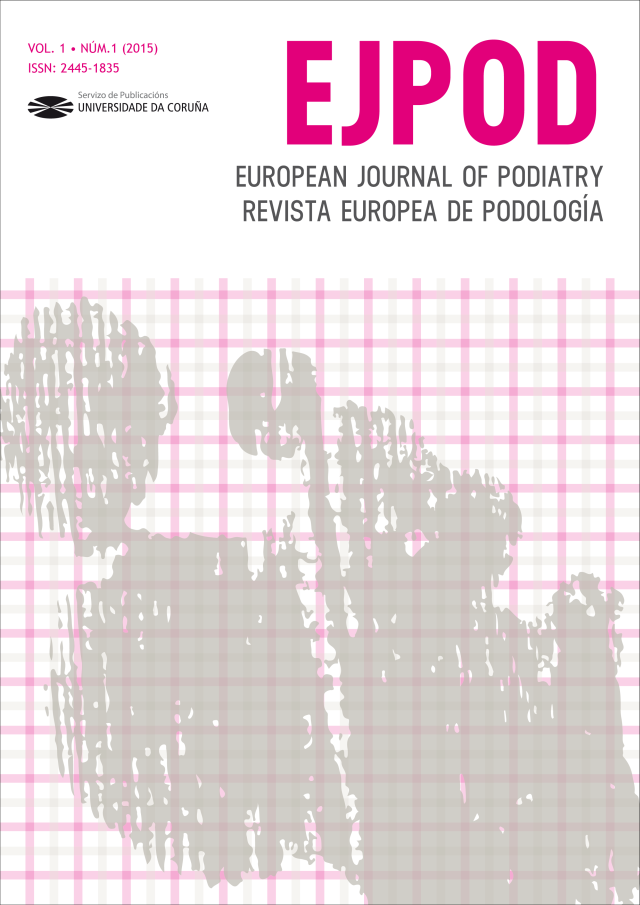Alterations produced in child pronator foot after endurance activities and its involvement with the physical fatigue
Main Article Content
Abstract
Objectives: This study was made with the objective of determine if there are alterations in child’s foot position and his footprint after a endurance activity and to establish wether these alterations are increased in pronator child compared to child who present neutral feet. At the same time, we relate all the above with the extreme physical fatigue and muscle aches that appear after physical activity. The aim of making this essay was to get to know, despite the controversy this topic arouses, if the pronator foot has some kind of disadvantage compared to the neutral foot and wheter it would need orthopedic podiatric treatment as a way to prevent and improve the child biomechanic alterations.
Material and Method: Foot position was consider through the Foot Posture Index (FPI-6), and the footprint through a pedigraphy, before and after aerobic endurance activities in order to calculate the Arch Index by applying the computer program AutoCad® to every print.
Results and Conclusions: According to the results, it can be concluded that the foot position and the children footprint was altered after endurance activities, pronators were more fatigated and complained about feet and legs aches during and/or after the activities. These results are statistically significant (P<0.05). However, there were no significant evidence (P>0.05) that these changes were higher in children with pronator feet or that their efficiency was lower during the exercise compared to neutral feet children.
Keywords:
Downloads
Article Details
References
Moreno JL. Podología deportiva. 2ºed.Madrid: Masson; 2005:416.
Moreno JL. Podología general y biomecánica. 2ª ed. Barcelona: Elsevier/Masson; 2009:448.
Tudor A, Ruzic L, Sestan B, Sirola L, Prpic T. Flat-footedness is not a disadvantage for athletic performance in children aged 11 to 15 years. Pediatrics. 2009; 123(3):386-392.
Barnes A, Wheat J, Milner CE. Fore- and Rearfoot Kinematics in High and Low Arched Individuals During Running. Foot Ankle Int. 2011; 32(7):710-716.
Queen RM, Mall NA, Nunley JA, Chuckpaiwong B. Differences in plantar loading between flat and normal feet during different athletic tasks. Gait Posture. 2009; 29(4):582-586.
Abián J, Alegre LM, Lara AJ, Jiménez L, Aguado X. Fuerzas de reacción del suelo en pies cavos y planos. Arch Med Deporte.2005; 22(108):285-292.
Levinger P, Murley GS, Barton CJ, Cotchett MP, McSweeney SR, Menz HB. A comparison of foot kinematics in people with normal and flat arched feet using the Oxford Foot Model. Gait Posture. 2010; 32(4):519-523.
Murphy DF, Connolly DA, Beynnon BD. Risk factors for lower extremity injury: a review of the literature. Br J Sports Med. 2003; 37(1):13-29.
Kaufman KR, Brodine SK, Shaffer RA, Johnson CW, Cullison TR. The effect of foot structure and range of motion on musculoskeletal overuse injuries. Am J Sports Med. 1999; 27(5):585-593.
Berdejo-del-Fresno D, Lara AJ, Martínez EJ, Cachón J, Lara S. Footprint modifications according to the physical activity practiced. Rev Int Med Cienc Act Fís Deporte.2013; 13(49):19-39.
Boozari S, Ashraf A, Ali M, Jafari H. Effect of Functional Fatigue on Vertical Ground-Reaction Force in Individuals With Flat Feet. J Sport Rehab. 2013; 22(3):177-183.
Escamilla-Martínez E, Martínez-Nova A, Gómez-Martín B, Sánchez-Rodríguez R, Fernández-Seguín LM. The effect of moderate running on foot posture index and plantar pressure distribution in male recreational runners. J Am Podiatr Med Assoc. 2013; 103(2):121-125.
Teyhen DS, Stoltenberg BE, Eckard TG, Doyle PM, Boland DM, Feldtmann JJ, et al. Static foot posture associated with dynamic plantar pressure parameters. J Orthop Sports Phys Ther. 2011; 41(2):100-107.
Delgado Abellán L, Aguado X, Jiménez Ormeño E, Mecerreyes L, Alegre LM. Efectos del ejercicio continuo e intermitente sobre la huella plantar. Arch Med Deporte. 2012; (148):601-608.
Arévalo JF. Los tipos de pie y su repercusión en el rendimiento motor. [Tesis Doctoral].Cádiz: Universidad de Cádiz; 2013.
Chang L, Myung K, Mi SC. The Relationship between Balance and Foot Pressure in Fatigue of the Plantar Intrinsic Foot Muscles of Adults with Flexible Flatfoot. J Phys Ther Sc. 2012; 24(8):699-701.
Shih YF, Chen CY, Chen WY, Lin HC. Lower extremity kinematics in children with and without flexible flatfoot: a comparative study. BMC Musculoskelet Disord. 2012; 13(1):31.
Redmon AC, Crane YZ, Menz HB. Normative values for the foot posture index. J Foot Ankle Res.2008; 1(1):6.
Evans AM. Relationship between “growing pains” and foot posture in children: single-case experimental designs in clinical practice. J Am Podiatr Med Assoc.2003, 93(2):111-117.
Kirby KA, Green DR. Foot and Ankle disorder in Children. SJ De Valentine. Evaluation and Nonoperative Management of Pes Valgus. New York: Churchill Livingstone; 1992: 295-327.
Yelling M, Lamb KL,Swaine IL.Validity of a pictorial perceived exertion scale for effort estimation and effort production during stepping exercise in adolescent children. European Physical Education Review 2002;8 (2):157-175.


